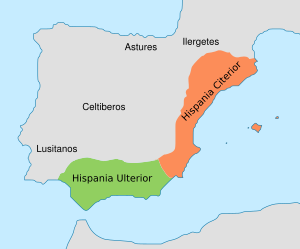Hispania Citerior facts for kids
Quick facts for kids Hispania Citerior |
|||||||
|---|---|---|---|---|---|---|---|
| Province of the Roman Republic | |||||||
| 197 BC–19 BC | |||||||
 Hispania Citerior in 197 BC (in orange) |
|||||||
| Historical era | Antiquity | ||||||
|
• Established
|
197 BC | ||||||
|
• Disestablished
|
19 BC | ||||||
|
|||||||
| Today part of | Spain | ||||||
Hispania Citerior was an important Roman province. Its name means "Nearer Spain" or "Hither Iberia." It was located on the eastern coast of what is now Spain. This area included parts of modern-day Catalonia and Valencia.
The main city in Hispania Citerior was Cartago Nova. Today, this city is known as Cartagena in the region of Murcia. To the south of Hispania Citerior was another Roman province called Hispania Ulterior. This name meant "Further Spain" because it was farther away from the city of Rome.
How the Provinces Were Formed
The Romans created Hispania Citerior and Hispania Ulterior in 197 BC. This was four years after the Second Punic War ended in 201 BC. During this war, the Roman general Scipio Africanus defeated the Carthaginians. This happened at the Battle of Ilipa in 206 BC.
After this victory, Rome took control of the Carthaginian lands. These lands included southern Spain and the eastern coast up to the River Ebro.
Wars and Changes
Governors of Hispania Citerior often fought wars. They battled against the Celtiberians, who lived to the west of the province. These conflicts helped Rome expand its control.
Later, around 19 BC, the Roman emperor Augustus reorganized the provinces. Hispania Citerior was replaced by a much larger province. This new province was called Hispania Tarraconensis. It included all the lands Rome had conquered in central, northern, and northwestern Spain.
Augustus also changed the name of Hispania Ulterior. It became Hispania Baetica. He also created a third new province called Hispania Lusitania.
What Does "Hispania" Mean?
The word Hispania is a Latin term. It was used by the Romans to describe the Iberian peninsula. This term was first used around 200 BC by a poet named Quintus Ennius.
Some historians believe the word might come from the Punic language. It could mean "coast of hyraxes". Hyraxes are small, furry mammals. However, Phoenician explorers might have confused the many rabbits in the area with hyraxes.
The Roman historian Cassius Dio wrote about the people of Hispania. He said they belonged to many different tribes. They did not all speak the same language. They also did not have one common government.
See also
 In Spanish: Hispania Citerior para niños
In Spanish: Hispania Citerior para niños
- Pre-Roman peoples of the Iberian Peninsula
- Hispania Ulterior
- Hispania Tarraconensis
- Hispania Baetica
- Hispania Lusitana

